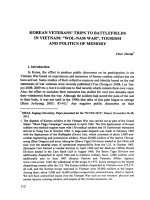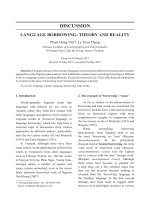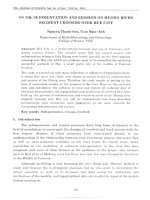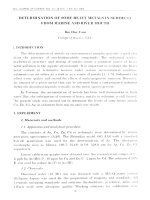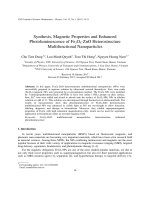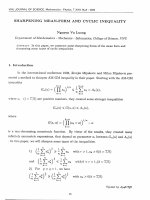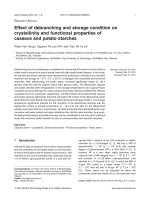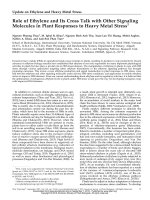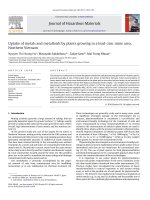DSpace at VNU: Multimode higher-order antibunching and squeezing in trio cont states
Bạn đang xem bản rút gọn của tài liệu. Xem và tải ngay bản đầy đủ của tài liệu tại đây (154.57 KB, 7 trang )
Home
Search
Collections
Journals
About
Contact us
My IOPscience
Multimode higher-order antibunching and squeezing in trio coherent states
This content has been downloaded from IOPscience. Please scroll down to see the full text.
2002 J. Opt. B: Quantum Semiclass. Opt. 4 222
( />View the table of contents for this issue, or go to the journal homepage for more
Download details:
IP Address: 129.93.16.3
This content was downloaded on 07/09/2015 at 09:59
Please note that terms and conditions apply.
INSTITUTE OF PHYSICS PUBLISHING
JOURNAL OF OPTICS B: QUANTUM AND SEMICLASSICAL OPTICS
J. Opt. B: Quantum Semiclass. Opt. 4 (2002) 222–227
PII: S1464-4266(02)32962-8
Multimode higher-order antibunching
and squeezing in trio coherent states∗
Nguyen Ba An
Institute of Physics, PO Box 429 Bo Ho, Hanoi 10000, Vietnam
and
Faculty of Technology, Hanoi National University, 144 Xuan Thuy, Cau Giay, Hanoi, Vietnam
Received 23 January 2002, in final form 22 March 2002
Published 21 May 2002
Online at stacks.iop.org/JOptB/4/222
Abstract
We study the multimode higher-order nonclassical effects of novel trio
coherent states. We show that such states exhibit antibunching to all orders
in the single-mode case. However, the two-mode higher-order antibunching
may or may not exist depending on the parameters. We also show that in
such states squeezing is fully absent in both single-mode and two-mode
situations. As for the three-mode case, the so-called sum-squeezing is
impossible but another kind of squeezing may arise for the orders K that are
a multiple of three. The degree of the lowest allowable K = 3 order
squeezing can reach a remarkable amount of 18%. Of interest is the
following property: when the order grows, the degree of antibunching
increases but that of squeezing decreases.
Keywords: Antibunching, squeezing, multimode, higher-order, trio coherent
state
1. Introduction
Current progresses, both theoretical and experimental, in quantum information science have led to the common recognition
that nonclassical features in the quantum world may be utilized in communication networks to achieve various tasks that
are impossible classically, such as quantum cryptography [1–
3], quantum teleportation [4, 5], quantum computation [6–9],
etc. For example, squeezed light can be applied to teleport
entangled quantum bits [10] and antibunched light is useful
to perform quantum communication and quantum computation [11]. Although actual utilizations for everyday needs are
still remote, nonclassical effects promise considerable potential applications in the future. Therefore, searches for and
study of new nonclassical states are welcome. In fact, it is
not impossible that a really adequate nonclassical state is still
undiscovered or that it is among the discovered ones but its
useful properties remain not properly exploited.
In addition to numerous known-to-date kinds of
nonclassical states, a novel kind has recently been
introduced [12].
These are trio coherent states which
generalize the so-called pair coherent states [13–20]. The
* This work is devoted to my teacher, Professor Nguyen Van Hieu, on the
occasion of his 65th birthday.
1464-4266/02/030222+06$30.00 © 2002 IOP Publishing Ltd
trio coherent state |ξ, p, q is defined as the right eigenstate
simultaneously of the operators abc, n a − n c and n b − n c
where n x = x + x, x = {a, b, c} with a, b and c being
bosonic annihilation operators of three independent boson
modes. (Note that different, more convenient, notations are
used here rather than those in [12].) That is,
abc|ξ, p, q = ξ |ξ, p, q
(1)
(n b − n c )|ξ, p, q = p|ξ, p, q
(2)
(n a − n c )|ξ, p, q = q|ξ, p, q
(3)
where ξ = r exp(iφ) with real r, φ is the complex eigenvalue
and p, q are referred to as ‘charges’ which, without loss of
generality, can be regarded as fixed non-negative integers.
These ‘charges’ serve as constants of motion in processes
in which the boson number changes only in trios (each trio
consists of one boson in mode a, one boson in mode b and one
boson in mode c). Among various representations [12] of the
trio coherent state, the most useful one is via Fock states |n x
|ξ, p, q = N ( p, q, r 2 )
∞
n=0
× |n + q a |n + p b |n
Printed in the UK
c
ξn
√
(n + p)!(n + q)!n!
(4)
222
Multimode higher-order antibunching and squeezing in trio coherent states
where N ( p, q, r 2 ) is the normalization coefficient given by
N ( p, q, r 2 ) = N (q, p, r 2 ) =
∞
n=0
r 2n
(n + p)!(n + q)!n!
−1/2
.
(5)
The mathematical properties of the state |ξ, p, q were studied
in detail in [12] in which it was also shown that the trio
coherent state exhibits sub-Poissonian number distribution, a
type of squeezing and violates Cauchy–Schwartz inequalities.
An experimental scheme towards generation of such states
was also proposed in [12]. In the present paper we further
investigate antibunching and squeezing of the trio coherent
state with respect to multimode and higher-order issues.
Section 2 is reserved for antibunching while squeezing is dealt
with in section 3. In each of the two sections, higher-order
effects are studied for single-mode, two-mode and three-mode
cases separately. Section 4 summarizes the main results of the
paper.
2. Higher-order antibunching
2.1. Single-mode antibunching
Single-mode higher-order antibunching is defined by the
fulfilment of the following inequality [21, 22]
n (l+1)
n (m−1)
< n (l)
n (m)
x
x
x
x
(6)
where . . . denotes the quantum average, x = {a, b, c},
l, m are integers satisfying the conditions l
m
1 and
l−1
n (l)
x ≡
j =0 (n x − j ). The usual (i.e. first-order) antibunching
corresponds to m = l = 1 for which equation (6) reduces to
n (2)
< nx
x
2
(7)
and the well-known inequality results
( nx )
2
≡
n 2x
− nx
2
< nx .
n (l+1)
x
n (l)
nx
x
< 1.
= r |q−l|−(q−l) N 2 ( p, q, r 2 )N −2
n (l)
a
|q − l| − (q − l)
(12)
× p+
, |q − l|, r 2 .
2
Similarly, for mode b,
N 2 ( p, q, r 2 )N −2 ( p − l, q, r 2 )
if p l
=
n (l)
b
2(l− p) 2
N ( p, q, r 2 )N −2 (l − p, q + l − p, r 2 )
r
if p l
(13)
which can also be rewritten jointly as
= r | p−l|−( p−l) N 2 ( p, q, r 2 )N −2
n (l)
b
| p − l| − ( p − l)
× q+
, | p − l|, r 2 .
2
As for mode c we obtain a simple formula
(14)
(15)
(8)
(9)
or, likewise,
A x;l ≡
We observe that n (l)
a depends in fact on p, q and q − l rather
than on p, q, l separately and we can rewrite equation (11)
jointly as
= r 2l N 2 ( p, q, r 2 )N −2 ( p + l, q + l, r 2 ).
n (l)
c
Here we consider the case of l m = 1 for which the lth-order
antibunching exists for mode x if
< n (l)
nx
n (l+1)
x
x
Figure 1. Single-mode third-order antibunching of mode a, Aa;3 , as
a function of r for p = 0 and q = 0, 1, 2, 3, 4, 5 (upwards at r = 8).
(10)
The function A x;l measures the degree of single-mode lth-order
antibunching; the smaller (larger) A x;l the larger (smaller) the
antibunching degree.
In the trio coherent state |ξ, p, q represented by
equation (4) we obtain for an arbitrary l
N 2 ( p, q, r 2 )N −2 ( p, q − l, r 2 )
if q l
n (l)
=
a
2(l−q)
r
N 2 ( p, q, r 2 )N −2 ( p + l − q, l − q, r 2 )
if q l.
(11)
Using equations (10), (12), (14) and (15) allows us to
study the modal antibunching in dependence on the parameters
involved. For mode a we find that it is antibunched to any
order l over the entire range of r, but the dependence of Aa,l
on r differs for q ∈ Q ≡ [1, l] (i.e. q = 1, 2, . . . , l) and for
q ∈ Q˜ ∈
/ [1, l] (i.e. q = 0, l + 1, l + 2, . . .). When q ∈ Q,
Aa,l equals zero at r = 0 and then grows with increasing
˜ Aa,l starts from a nonzero value at
r . However, when q ∈ Q,
r = 0 and then also grows with r . These behaviours are clearly
seen from figure 1. Furthermore, this figure indicates the
˜ and q1 < q2 , i.e.
relation Aa,l (q1 ) < Aa,l (q2 ) if q1,2 ∈ Q ( Q)
the antibunching degree decreases with increasing q for given
l, p and r . Concerning the p-dependence, an opposite relation
holds: Aa,l ( p1 ) > Aa,l ( p2 ) if p1 < p2 , i.e. the antibunching
degree increases with increasing p for fixed l, q and r . A
somewhat surprising feature is that antibunching of a higher
order turns out to be more prominent, i.e. the antibunching
degree increases with growing l for parameters otherwise fixed
(see figure 2). Thus, speculatively, higher-order antibunching
might play a role superior to usual antibunching. Note that such
a prominence of higher-order antibunching was discovered for
the first time in [22] for two-mode coherent states.
223
Nguyen Ba An
(a)
(b)
Figure 2. Single-mode lth-order antibunching of mode a, Aa;l , as a
function of the order l at r = 4 and p = q = 2 (circles) and
p = q = 4 (triangles).
The above-mentioned properties remain true for mode b
with the roles of p and q being exchanged.
As for mode c, it is also antibunched to any order l over
the whole range of r, but a different behaviour arises. Namely,
when p (q) is fixed and q ( p) grows, Ac,l decreases at small r
but increases at large r . Nevertheless, it is found that, similar to
the situation with modes a and b, mode c is more antibunched
for a higher order as well.
For two arbitrary modes x and y (x = y = {a, b, c}), the twomode higher-order antibunching is defined by the fulfilment of
the inequality [21]
(16)
where l
m
1. For simplicity we limit ourselves to the
case with l m = 1 for which equation (16) reduces to
(l)
n (l+1)
+ n (l+1)
< n (l)
x
y
x n y + n y nx .
(17)
Likewise, two modes x and y are said to be antibunched to
order l if A x,y;l < 1 where
A x,y;l =
n (l+1)
+ n (l+1)
x
y
(l)
n (l)
x n y + n y nx
(18)
is a measure of two-mode lth-order antibunching.
The two-mode higher-order antibunching was dealt with
for pair and generalized pair coherent states in [21]. Here
we study this effect for the trio coherent state for which our
calculations yield for any positive integers l, m the following
analytic expressions of the averaged values of interest:
(m)
n (l)
a nb
2
N ( p, q, r 2 )N −2 ( p − m, q − l, r 2 )
if p m&q l
r 2(l−q) N 2 ( p, q, r 2 )N −2 ( p − m + l − q, l − q, r 2 )
=
(19)
if l − q m − p&l q
r 2(m− p) N 2 ( p, q, r 2 )N −2 (m − p, m − p + q − l, r 2 )
if m
p&m − p l − q
224
(m)
n (l)
a nc
r 2m N 2 ( p, q, r 2 )N −2 ( p + m, q − l + m, r 2 )
if m l − q
(20)
=
2(l−q)
N 2 ( p, q, r 2 )N −2 ( p + l − q, l − q − m, r 2 )
r
if l − q m
and
2.2. Two-mode antibunching
(m)
(l) (m)
n (l+1)
n (m−1)
+ n (l+1)
n (m−1)
< n (l)
x
y
y
x
x n y + n y nx
Figure 3. Two-mode lth-order antibunching Aa,b;l as a function of r
for p = 0, q = 0, 1, 2, 3, 4, 5 (upwards) and (a) l = 2 and (b) l = 3.
(m)
n (l)
b nc
r 2m N 2 ( p, q, r 2 )N −2 (q + m, p − l + m, r 2 )
if m l − p
(21)
=
2(l−
p)
N 2 ( p, q, r 2 )N −2 (q + l − p, l − p − m, r 2 )
r
if l − p m.
The above expressions assign delicate dependences of the twomode higher-order antibunching on the problem parameters.
Our treatment is confined to the case with p = 0 and q, r , l
varying. As a result, we discover that no antibunching arises
for q > l. When q
l the two-mode antibunching occurs
with distinct behaviours for q < l and q = l. In the former
situation A x,y;l equals zero at r = 0 and increases with r ,
while in the latter situation A x,y;l equals unity at r = 0 and
decreases with increasing r . Figure 3 plots, for example, Aa,b;l
as a function of r for p = 0 and various values of l and q to
confirm the above conclusions concerning the role of the charge
q on antibunching of order l. Also, as well as for the singlemode case, we find that the two-mode antibunching degree is
larger for a higher order.
3. Higher-order squeezing
3.1. Single-mode squeezing
Following Hillery [23] we consider the modal K th power
amplitude component operator
Q x (K , ϕ) = 12 ((x + ) K eiϕ + x K e−iϕ )
(22)
where x = {a, b, c}, K = 1, 2, 3, . . . and ϕ is a phase
determining the direction of x K in the complex plane.
Multimode higher-order antibunching and squeezing in trio coherent states
The operators (22) for phases differing by π/2 obey the
commutation relation
i
[Q x (K , ϕ), Q x (K , ϕ + π/2)] = Fx (K )
2
(23)
with Fx (K ) given by [24]
K
Fx (K ) =
l=1
K !K (l)
(x + ) K −l x K −l
(K − l)!l!
(24)
where K (l) ≡ l−1
j =0 (K − j ). A state is said to be squeezed in
mode x to an order K if there exists an angle ϕ such that
Sx (K , ϕ) ≡ ( Q x (K , ϕ))2 −
Fx (K ) < 0.
1
4
1
2
)
n (K
x
(26)
which is ϕ-independent and always positive. This implies
the absence of single-mode squeezing to any order in the trio
coherent state.
3.2. Two-mode squeezing
(27)
where x = y = {a, b, c}, K = 1, 2, 3, . . . and ϕ is a phase
determining the direction of (x + y) K in the complex plane.
These operators obey the commutation relation
[Q x y (K , ϕ), Q x y (K , ϕ + π/2)] =
i
Fx y (K )
4
Fx y (K ) = (x + y) K (x + + y + ) K − (x + + y + ) K (x + y) K . (29)
A state is said to be two-mode squeezed to an order K if there
exists an angle ϕ such that
Fx y (K ) < 0.
1
8
(30)
The K = 1 case reproduces the usual two-mode squeezing
introduced by Loudon and Knight [26]. It is not difficult to
check that in the trio coherent state
Sx y (K , ϕ) =
1
4
K
l=0
K!
(K − l)!l!
2
) (K −l)
n (K
x ny
(32)
where K = 1, 2, 3, . . . and ϕ is a phase determining the
direction of (abc) K in the complex plane. For any ϕ, the
following commutation relation holds
i
L(K )
2
[P(K , ϕ), P(K , ϕ + π/2)] =
(33)
where L(K ) is given by
L(K ) = (abc) K (a + b+ c+ ) K − (a + b+ c+ ) K (abc) K .
(34)
A state is said to be three-mode sum-squeezed to an order K
if there exists an angle ϕ such that
U (K , ϕ) ≡ ( P(K , ϕ))2 −
1
4
L(K ) < 0.
(35)
The lowest-order K = 1 case reproduces the usual three-mode
sum-squeezing [29].
In the trio coherent state we obtain
(36)
) (K ) (K )
× cos[2(K φ − ϕ)] + 2 n (K
].
a nb nc
(37)
At first glance, both equations (36) and (37) contain a phase
dependence and sum-squeezing is expected to occur. Yet, a
simple trigonometric manipulation in
U (K , ϕ) ≡ P 2 (K , ϕ) − P(K , ϕ)
2
−
1
4
L(K )
(38)
casts it into
(28)
with Fx y (K ) given by
Sx y (K , ϕ) ≡ ( Q x y (K , ϕ))2 −
P(K , ϕ) = 12 [(a + b+ c+ ) K eiϕ + (abc) K e−iϕ ]
P(K , ϕ) = r K cos(K φ − ϕ)
P 2 (K , ϕ) = 14 [ L(K ) + 2r 2K
In the two-mode situation let us consider the operator
1
Q x y (K , ϕ) = √ ((x + + y + ) K eiϕ + (x + y) K e−iϕ )
2 2
The first kind of three-mode squeezing which we consider in
this sub-section is related to the so-called sum-squeezing [27].
The concept of the general multimode (first-order) sumsqueezing has been introduced in [28]. Higher-order sumsqueezing in the three-mode case can be defined in terms of
the operators
(25)
The lowest-order K = 1 case reproduces the usual squeezing
introduced by Stoler [25]. In the trio coherent state it is easy
to verify for arbitrary K and x that
Sx (K , ϕ) =
3.3. Three-mode squeezing
(31)
for any order K as well as any pair of modes. This equation (31)
indicates that there are no angles ϕ that can make Sx y (K , ϕ)
negative. Hence, no two-mode squeezing can appear in the
trio coherent state. It is worth noting, however, that two-mode
squeezing exists in the pair coherent state [13, 14].
(K )
)
(K )
U (K , ϕ) = 21 [ n (K
− r 2K ]
a nb nc
(39)
which abandons any phase dependences. Thus, unexpectedly,
the sum-squeezing defined by equation (35) is impossible to
any order K . To gain more insight into the physics implied
) (K ) (K )
by equation (39) let us calculate the quantity n (K
.
a nb nc
For later use, we have derived the general analytic expression
(m) (s)
in the trio coherent state for arbitrary positive
of n (l)
a nb nc
integers l, m and s in the form:
(m) (s)
n (l)
= r 2s N 2 ( p, q, r 2 )N −2 (s + p − m, s + q − l, r 2 )
a nb nc
(40)
if l, m and s meet one of the following four conditions (i)
p
m, q
l, (ii) p < m, q
l, s
m − p, (iii) p
m,
q < l, s l − q and (iv) p < m, q < l, s {l − q, m − p};
(m) (s)
= r 2(l−q) N 2 ( p, q, r 2 )
n (l)
a nb nc
× N −2 (l − q + p − m, l − q − s, r 2 )
(41)
if l, m and s meet one of the following two conditions (i)
p m, q < l, l − q s, (ii) p < m, q < l, l − q {s, m − p}
and
(m) (s)
= r 2(m− p) N 2 ( p, q, r 2 )
n (l)
a nb nc
× N −2 (m − p + q − l, m − p − s, r 2 )
(42)
225
Nguyen Ba An
if l, m and s meet one of the following two conditions (i)
p < m, q l, m− p s, (ii) p < m, q < l, m− p {s, l−q}.
) (K ) (K )
=
Making use of the above formulae yields n (K
a nb nc
2K
r for any positive integer K . That is, U (K , ϕ) ≡ 0 due to
equation (39) and, hence, the trio coherent state is a state of
minimum uncertainty in which the uncertainty of P(K , ϕ) is
equal in all directions.
The uncertainty region is a circle of
√
radius R = 12 L(K ) with L(K ) determined explicitly by
K
K
K
L(K ) =
l=0 m=0 s=0
(m) (s)
(K !)6 n (l)
a nb nc
(l!m!s!)2 (K −l)!(K −m)!(K −s)!
) (K ) (K )
− n (K
.
a nb nc
(43)
Numerical calculations of equation (43) show that the
uncertainty circle radius quickly increases with both K and
r.
Another kind of three-mode higher-order squeezing is
associated with the operators
1
Q(K , ϕ) = √ [(a + + b+ + c+ ) K eiϕ + (a + b + c) K e−iϕ ] (44)
2 3
where K = 1, 2, 3, . . . and ϕ is a phase determining the
direction of (a + b + c) K in the complex plane. These
operators, for an arbitrary ϕ, obey the commutation relation
[Q(K , ϕ), Q(K , ϕ + π/2)] =
i
F(K )
6
(45)
with F(K ) given by
F(K ) = (a+b+c) K (a + +b+ +c+ ) K −(a + +b+ +c+ ) K (a+b+c) K .
(46)
A state is said to be three-mode squeezed to an order K if there
exists an angle ϕ such that
S (K , ϕ) ≡ ( Q(K , ϕ))2 −
1
12
F(K ) < 0.
[ (a + b + c) K e−iϕ ]}.
(48)
In the trio coherent state our calculations yield
(a + b + c) K = δ K ,3m
(a + b + c)2K
K!
ξ K /3
((K /3)!)3
(2K )!
= δ K ,3m
ξ 2K /3
((2K /3)!)3
(49)
(50)
where m is a positive integer, and
(a + + b+ + c+ ) K (a + b + c) K
K
l
=
l=0 s=0
K!
(K − l)!(l − s)!s!
2
−l) (l−s) (s)
n (K
nb nc .
a
(51)
−l) (l−s) (s)
The averages n (K
n b n c appearing in equation (51) are
a
to be evaluated by virtue of equations (40), (41) or (42). From
equations (48)–(51) we observe that, if K = 3m, then
S (K , ϕ) =
1
6
K
l
l=0 s=0
K!
(K − l)!(l − s)!s!
2
−l) (l−s) (s)
n (K
nb nc
a
(52)
226
S (K , ϕ) =
+
×
1 2K /3
(2K )!
cos[2(K φ/3 − ϕ)]
r
6
((2K /3)!)3
2(K !)2
cos2 (K φ/3 − ϕ) +
((K /3)!)6
2
K!
(K − l)!(l − s)!s!
l
K
l=0 s=0
−l) (l−s) (s)
n (K
nb nc
a
.
(53)
The phase dependence is transparent from equation (53) and for
appropriate φ and ϕ one may have negative S (K , ϕ) resulting
in a three-mode squeezing.
The squeezing degree is assessed by the quantity
S(K , ϕ) =
12S (K , ϕ)
F(K )
(54)
where F(K ) is explicitly determined by
S (K , ϕ) = 16 { (a + + b+ + c+ ) K (a + b + c) K
2
which is phase-independent and always positive, meaning no
three-mode squeezing. In other words, three-mode squeezing,
in the sense of equation (47), may occur only for K being a
multiple of three. For such K
(47)
In terms of annihilation/creation operators S (K , ϕ) reads
+ [ (a + b + c)2K e−2iϕ ] + 2
Figure 4. Three-mode squeezing degree S, equation (54), as a
function of r for p = q = 0, K φ/3 − ϕ = π/2 and K = 3 and
K = 6.
K
l
F(K ) =
l=0 s=0
K!
(K − l)!(l − s)!s!
2
K −l l−s
s
m=0 u=0 v=0
(u) (v)
((K − l)!(l − s)!s!)2 n (m)
a nb nc
×
(m!u!v!)2 (K − l − m)!(l − s − u)!(s − v)!
−l) (l−s) (s)
− n (K
nb nc
a
.
(55)
By the definition (54), the ideal squeezing corresponds to
S = −1. An extensive graphical work based on the above
analytically derived formulae has indicated that squeezing is
most favourable when p = q = 0 and K φ = 3(ϕ + π/2).
Under such conditions we draw in figure 4 the squeezing degree
S as a function of r for the two lowest allowable orders K = 3
and K = 6. For each value of K , squeezing appears in
the small-r side and disappears in the large-r side. The r range in which squeezing occurs widens for increasing order
K . It is also clear that squeezing becomes worse for a higher
order, a fact which is opposed to antibunching (see section 2).
Quantitatively, for K = 3 the maximal degree of three-mode
squeezing is about 18%, whereas for K = 6 it is just around
9%.
Multimode higher-order antibunching and squeezing in trio coherent states
4. Conclusion
In conclusion, we have extended the consideration of trio
coherent states introduced in a previous paper [12] to the case of
multimode higher-order antibunching and squeezing. We have
proven that single-mode antibunching exists to all orders but
two-mode antibunching arises only under certain constraints
imposed upon l, p and q. We have elucidated in detail the
dependences on the parameters involved. Of particularity is
the increase of antibunching degree when the order grows,
a fact emphasizing the role of higher-order antibunching as
compared to that of the usual antibunching. We have also
explicitly shown that, in the trio coherent state, squeezing to
any order has nothing to do with the single-mode and twomode situations. In the three-mode case, sum-squeezing does
not appear either. However, its analysis has revealed the trio
coherent state as a kind of minimum uncertainty state. Only
the kind of three-mode higher-order squeezing defined by
equation (47) turns out to be possible but not for any orders K .
The allowed orders have been found to be a multiple of three.
In contrast to antibunching, the degree of such a three-mode
squeezing decreases with increasing K . This kind of squeezing
is worth attention since it possesses a remarkable maximal
amount of squeezing: 18% for K = 3 and 9% for K = 6.
An extension of the trio coherent state to nonlinear trio
coherent states including odd/even trio coherent states is now
under way.
Finally, it is important to remember that, though an
experimental scheme for generating the trio coherent state was
suggested in [12], further work is worthwhile towards a real
implementation of such a state.
Acknowledgments
The author is indebted to Professor Nguyen Van Hieu, his
teacher, for the constant attention and encouragement in
the author’s entire scientific career. The present paper is
respectfully dedicated to Professor Nguyen Van Hieu on his
65th birthday. This work was supported by the National Basic
Science Project KT-04.1.2 and by the Faculty of Technology
of HNU.
References
[1] Wiesner S 1983 SIGACT News 15 78
[2] Bennett C H and Brassard G 1985 IBM Tech. Discl. Bull. 28
3153
[3] Ekert A K 1991 Phys. Rev. Lett. 67 661
[4] Bennett C H et al 1993 Phys. Rev. Lett. 70 1895
[5] Furusawa A et al 1998 Science 282 706
[6] Gottesman D and Chuang I 1999 Nature 402 390
[7] Benioff P 1980 J. Stat. Phys. 22 563
[8] Feynman R P 1982 Int. J. Theor. Phys. 21 467
[9] Deutsch D 1985 Proc. R. Soc. A 400 97
[10] Gorbachev V N, Zhiliba A I and Trubiko A I 2001 J. Opt. B:
Quantum Semiclass. Opt. 3 S25
[11] Raginsky M and Kumar P 2001 J. Opt. B: Quantum Semiclass.
Opt. 3 L1
[12] Nguyen B A and Truong M D 2002 J. Opt. B: Quantum
Semiclass. Opt. 4 80
[13] Agarwal G S 1986 Phys. Rev. Lett. 57 827
[14] Agarwal G S 1988 J. Opt. Soc. Am. B 5 1940
[15] Gou S C, Steinbach J and Knight P L 1996 Phys. Rev. A 54
R1014
[16] Gou S C, Steinbach J and Knight P L 1996 Phys. Rev. A 54
4315
[17] Gou S C, Steinbach J and Knight P L 1997 Phys. Rev. A 56
4815
[18] Gerry C C 1997 Phys. Rev. A 55 2478
[19] Liu X M 2001 Phys. Lett. A 279 123
[20] Zheng S B 2001 J. Opt. B: Quantum Semiclass. Opt. 3 298
[21] Lee C T 1990 Phys. Rev. A 41 1569
[22] Lee C T 1990 Phys. Rev. A 41 1721
[23] Hillery M 1987 Opt. Commun. 62 3135
[24] Nguyen B A 1997 Phys. Lett. A 234 45
[25] Stoler D 1970 Phys. Rev. D 3217
[26] Loudon R and Knight P L 1987 J. Mod. Opt. 34 709
[27] Hillery M 1989 Phys. Rev. A 40 3147
[28] Nguyen B A and Vo T 1999 Phys. Lett. A 261 334
[29] Kumar A and Gupta P S 1997 Opt. Commun. 136 441
227
